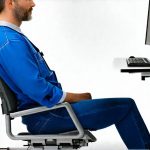Prolonged sitting has become an unavoidable part of modern life for many. From office workers spending eight hours at a desk to commuters enduring lengthy drives, our bodies are increasingly accustomed to extended periods in a seated position. While seemingly innocuous, this sedentary behavior is raising concerns among healthcare professionals regarding its potential impact on various aspects of health – and the prostate gland is beginning to garner significant attention within that discussion. It’s not necessarily about sitting itself being inherently evil, but rather the cumulative effects of prolonged inactivity and pressure in a specific region of the body, combined with other lifestyle factors. Understanding these potential connections is crucial for proactive health management, especially as men age and become more susceptible to prostate-related issues.
The prostate gland, responsible for producing fluid that nourishes and transports sperm, is particularly vulnerable due to its anatomical location. It sits relatively close to the pelvic floor muscles and can be directly affected by pressure from sustained sitting. This isn’t to alarm anyone – simply highlighting a growing area of research and emphasizing the importance of being mindful of our habits. Many factors contribute to prostate health, including genetics, diet, and overall lifestyle, so focusing solely on sitting would be an oversimplification. However, ignoring this potential link could lead to missed opportunities for preventative measures and optimized well-being. The goal here is to provide informed insights, not induce fear, but empower readers with knowledge to make conscious choices about their health.
The Mechanics of Pressure & Prostate Health
The connection between prolonged sitting and prostate concerns isn’t straightforward, but it revolves around several key mechanical factors. When you sit for extended periods, the pressure increases in the perineum – the area between the genitals and the anus. This pressure directly impacts the prostate gland itself, as well as surrounding structures like the pelvic floor muscles and nerves. – Increased pressure can potentially reduce blood flow to the prostate. Reduced circulation hinders the delivery of essential nutrients and oxygen, and impairs waste removal, contributing to inflammation and cellular dysfunction. – The sustained compression can also affect nerve function in the area, leading to discomfort or even contribute to chronic pelvic pain syndromes. – Furthermore, prolonged sitting often leads to weakened pelvic floor muscles. These muscles play a vital role in supporting the prostate and urinary bladder; weakening them can exacerbate existing issues or create new ones. It’s important to remember that the degree of impact will vary based on individual anatomy, posture, and other lifestyle habits.
This isn’t limited to traditional desk jobs either. Activities like long-distance driving, cycling (especially with a poorly fitted seat), and even prolonged video gaming can all contribute to this pressure. The type of seating also matters significantly. Soft, unsupportive chairs or seats offer little in the way of proper ergonomic support, amplifying the negative effects. Conversely, ergonomically designed chairs that distribute weight evenly and encourage good posture can minimize these risks. It’s about finding a balance between necessary sitting and mitigating its potential downsides. The goal isn’t to eliminate sitting entirely—that’s unrealistic for most people—but rather to understand how to modify our behavior to reduce the strain on this vital gland.
The impact is also cumulative. Occasional periods of prolonged sitting are unlikely to cause significant harm, but consistently subjecting the prostate to increased pressure over months and years can contribute to a variety of issues. It’s like any other part of the body—consistent stress without adequate recovery will eventually take its toll. This underscores the importance of incorporating regular movement breaks throughout the day. Simple strategies like standing up every 30-60 minutes, walking around briefly, or doing some light stretches can make a substantial difference in mitigating these risks.
Understanding Prostate Conditions & Potential Links
The prostate gland is susceptible to several conditions as men age, and while sitting isn’t necessarily a direct cause of any of them, it may exacerbate existing problems or contribute to their development. Here are some key areas of concern: 1. Benign Prostatic Hyperplasia (BPH): This common condition involves enlargement of the prostate gland, which can lead to urinary symptoms such as frequent urination, difficulty starting or stopping urination, and a weak urine stream. While BPH is primarily age-related, research suggests that prolonged sitting may worsen these symptoms by increasing pressure on the prostate and potentially contributing to inflammation. 2. Prostatitis: This refers to inflammation of the prostate gland and can cause pain in the groin, lower back, or perineum, as well as urinary difficulties. Again, while not directly caused by sitting, chronic pelvic floor muscle tension stemming from prolonged sitting could contribute to prostatitis symptoms. 3. Prostate Cancer: Prostate cancer is a more serious concern, and research on its link to sitting is still evolving. However, some studies suggest that men who spend a lot of time sitting may have a slightly increased risk of developing prostate cancer, although the exact mechanisms are not fully understood. It’s crucial to emphasize that many other factors play a much larger role in prostate cancer development.
It’s also important to differentiate between correlation and causation. Just because there’s an association between prolonged sitting and certain prostate conditions doesn’t mean that one directly causes the other. There could be other underlying factors at play, such as genetics, diet, or lack of physical activity. However, recognizing these potential links is a valuable step toward proactive health management. Regular check-ups with a healthcare professional are essential for early detection and treatment of any prostate issues. Early detection significantly improves the prognosis for most conditions.
Furthermore, it’s crucial to remember that lifestyle factors interact with each other. A sedentary lifestyle often goes hand-in-hand with poor diet, lack of exercise, and increased stress – all of which can negatively impact prostate health. Addressing these interconnected issues is key to overall well-being. Focusing solely on sitting without addressing the broader picture would be a missed opportunity for comprehensive health optimization.
Strategies for Mitigation: Beyond Just Standing Up
While standing up periodically is helpful, mitigating the potential negative effects of prolonged sitting requires a more holistic approach. Here are some strategies to consider: – Ergonomic Assessments: Have your workspace evaluated by an ergonomics specialist to ensure proper chair support, desk height, and monitor placement. This can significantly reduce pressure on the perineum and promote good posture. – Pelvic Floor Exercises (Kegels): Strengthening the pelvic floor muscles can provide better support for the prostate and urinary bladder. These exercises are relatively simple to do and can be incorporated into your daily routine. – Regular Exercise: Aim for at least 30 minutes of moderate-intensity exercise most days of the week. This helps improve blood flow, reduce inflammation, and strengthen overall muscle tone. – Dietary Considerations: A diet rich in fruits, vegetables, and healthy fats may help protect against prostate issues. Some studies suggest that foods containing lycopene (tomatoes, watermelon) and selenium (Brazil nuts, tuna) may be particularly beneficial.
Beyond these general recommendations, consider incorporating micro-movements throughout the day. Even small movements like ankle rotations, shoulder shrugs, or gentle stretches can help improve circulation and prevent stiffness. Consider using a standing desk converter to alternate between sitting and standing positions. If you drive long distances, take frequent breaks to get out of the car and stretch your legs. For cyclists, ensure proper seat height and consider using padded cycling shorts.
It’s also important to be mindful of your posture while sitting. Avoid slouching or leaning forward, as this increases pressure on the perineum. Keep your back straight, shoulders relaxed, and feet flat on the floor. Consider a lumbar support cushion to provide additional support for your lower back. The key is to create a comfortable and supportive environment that minimizes strain on the prostate gland. Ultimately, proactive health management involves making conscious choices about our lifestyle habits and taking steps to mitigate potential risks.
The Role of Preventative Care & Medical Consultation
Regular check-ups with a healthcare professional are paramount for maintaining optimal prostate health. These check-ups often include a digital rectal exam (DRE) and a Prostate-Specific Antigen (PSA) test, which can help detect early signs of prostate cancer or other issues. Don’t hesitate to discuss your concerns with your doctor, especially if you experience any urinary symptoms or pelvic pain. They can provide personalized advice based on your individual risk factors and medical history. Remember that screening recommendations vary depending on age, race, and family history, so it’s important to have an open conversation with your physician about what’s right for you.
Preventative care extends beyond routine screenings. It also involves adopting a healthy lifestyle that includes regular exercise, a balanced diet, and stress management techniques. These measures can help reduce inflammation, improve circulation, and boost the immune system – all of which are beneficial for prostate health. Additionally, staying well-hydrated is essential for maintaining proper urinary function and preventing constipation, which can put additional pressure on the prostate.
Finally, it’s crucial to avoid self-diagnosis or relying solely on information found online. This article provides general insights into the potential link between prolonged sitting and prostate health, but it should not be considered medical advice. Always consult with a qualified healthcare professional for any concerns about your health. They can provide accurate diagnoses, personalized treatment plans, and ongoing support to help you maintain optimal well-being. The information presented here is intended to empower readers to make informed decisions about their health, but it’s no substitute for professional medical guidance.





















